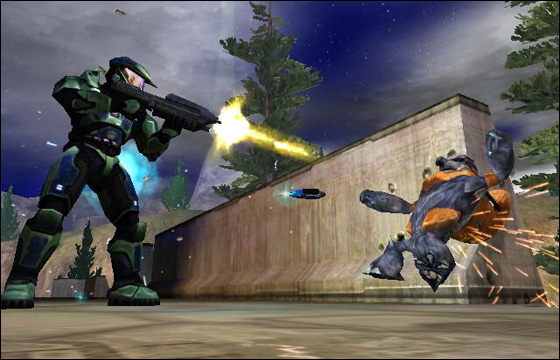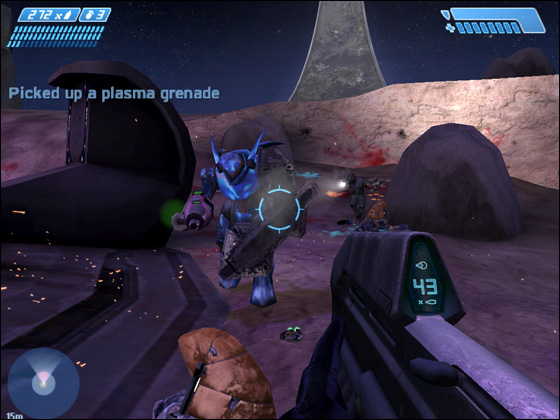Halo – Building the New Standard
September 12th, 2009

I squirm to consider that I’m a man who holds grudges, but the truth is I do, and do so considerably badly. When it comes to games, I’ve been unjustly bagging the Halo series for years now. Truth is, I never have (and I still don’t) like Microsoft’s presence in the games industry and by association I’ve always begrudged their flagship franchise Halo.
I think I’ve grown a little wiser over time which has allowed my fledging hate to simmer down to a mild bias. Although I still have that bias, as a player, my tastes genuinely do not match with the older male demographic and semi-PC flavour of gaming which Microsoft’s consoles feed so well. It’s not a dislike, but it’s not a preference either, which is round about where Halo and Halo 2 step in.
Halo and Halo 2 are fantastic titles and mostly worthy of the great sales and critical acclaim. At the same time, this PC pairing (yes, I cheated, bwhaha) are most definitely not to everyone’s taste, nor are they entirely well designed in places. I’ll leave the latter for another post though, and for now concentrate on why, despite some detestation from minorities, Halo is significant not just as a game but as a cultural fixture of this industry.
Categorically I can slice this two ways – and I don’t want to confuse either, so I’m going to split them up into two posts. The first being Halo as the new standard of (console) first person shooting, the second being Halo as a design, as an iteration of science fiction. The former is obviously far more important than the latter, so let’s begin then with that.
The New Standard
There are several prominent design choices and mechanics which set Halo apart from prior first person shooter games, collectively culminating in a distinctively new-gen breed of the first person play experience. (God that sounds so PR-driven >_<). These new experiences were larger and more diverse, sophisticated yet streamlined, requiring a series of different tactics and consideration sets for players to wrap their heads around. Let’s look at how Halo, as a design, reinvented the FPS genre.
NB: I’m not a history buff on my first person shooter games, so maybe the Halo games weren’t the first to utilize some of the examples below, but the packaging and refinement is what made them such a game-changer for the genre.
(If we’re talking new-gen FPS, the Halo approach to FPS design sits prominently alongside the corridor-shooter (Wolfenstein, Fear), the open-world shooter (Farcry 2, Fallout 3) and the roller-coaster shooter (Call of Duty 4) variations constituting the modern family of FPS game design.)
Wide Open Spaces
Significant forebearers to Halo such as Doom and Quake (and their respective, innumerous clones) were largely set in cramped, indoor labyrinths, rarely revealing the player to the outside world. Later first person games such as Turok: Dinosaur Hunter and GoldenEye evolved a little, firmly setting themselves in outdoor reality. Yet, similarly to the outdoor levels in Doom, for all intents and purposes the new terrain was primarily a switch in décor. The levels in Goldeneye, Turok and others were still pretty boxy, maintaining the archaic, pattern-based level design from them progenitors*.
*Turok in particular technically broke out of this design, but the short draw distance obscured it from being fully realized.

Halo‘s worlds step outside of these confines. The second, self-titled level in the original Halo (ie. Halo) is perhaps the most salient example of natural FPS terrain. Halo is set in a deep valley with a series of wide open expanses which connect to a junction of ravines leading down into areas with their own individual objectives. The landscape is natural; excessive, wide and shaped by slopes and hills. Unlike prior FPS games whose landscape was characterized in a very reductive, mathematical fashion (id games are exceptional for their formulaic level design), Halo‘s world was nature itself.
“Finish the Fight”
Due to the increased size of open, playable landmass, Halo‘s landscapes required a greater number of enemy AI to fill the levels, otherwise the sparse landscape would’ve probably been rather uneventful. Hence, every level is populated by a relatively dense number of enemy AI (the Covenant) who coordinate their attacks in squads. Master Chief (protagonist) himself is frequently accommodated by a pop-in, pop-out team of marines too, the frat-boy UNSC army. The large environments and greater number of units in play at the one time (all pretty intelligent, ‘mind), create a suitably war-like experience. Rather than playing the role of one man trudging through hell, Halo makes you feel as though your participating in a larger conflict, giving credence to the slogan “Finish the Fight”*. This feeling of participating in this arduous struggle is aided by the long-play length that most missions run, and helps the world feel real and engaging.
*”Finish the Fight” was the marketing slogan for Halo 3. It’s related to the conclusion of Halo 2.
Squads
I sort of already covered this point, didn’t I? It speaks for itself really; playing as a squad presents a different dynamic to the one-man-army approach. Although it’s hard to care about the UNSC meat shields – and the franchise never really makes them important, anyways – having friendlies on your side gives plausibility to the game world.
Vehicles
It might seem cliché nowadays, but before Halo very few FPS games featured vehicle sections…
*Ponders playing Doom II with a warthog*
Vehicles make a lot of sense when you’re dealing with a slow-moving, armor-plated, super-soldier stuck out in the wilderness with nowhere to go. The warthog, and to a lesser extent the other vehicles, are therefore genius inventions. Not only are they appropriate for the given context, but they also allowed a team mate to join in on the back turret, hence facilitating their use in multiplayer. Oh, and they actually give those meat shields something to do.

I may have mentioned before that FPS games can easily grow stale due to an inherent lack of interplay, the vehicles are therefore a nice distraction from this grindyness of the genre. Their portable nature allows the player to, at whim, unwind from the constant stream of FPS action. The device also works as a directive tool, giving developers greater control of the game’s momentum and pacing. As with how the overhead bombing run in Call of Duty 4 was managed, vehicle sections, such as the tank sequence early on in Halo 2, slows the pace and gives the player respite before another adrenalin shot. It’s worth mentioning that vehicles nicely accommodate the other bullet points too. (I guess it doesn’t need to be said but each point compounds with the others).
Two “Slot” Weapon Restriction
I guess this plays into the realism of war; holding 3 rifles, 2 pistols, a plasma gun, a handful of grenades and a rocket launcher kinda isn’t realistic. The Halo games are stringent in their weapons handling and only allow two “slots”. I say “slots” because technically you can hold three weapons when you dual-wield in Halo 2. By imposing this limitation it forces the player to be more mindful of their weapon set and the availability of weapons as dropped by the Covenant. It’s in this way that the two slot restriction plugs back into the large environments. Larger environments means greater distances between yourself and unoccupied weapons, with the hefty limitations imposed on weapon selection, by necessity of the shifting conflict, the player switches up their weaponry more frequently and hence must pay closer consideration to the environment around them if they are to acquire said weapons.
Health Regen
Health Regen is another switch up to convention which has interesting side effects. Firstly, it further implants you into the “you’re a bad ass, don’t forget it!” mentality which the narrative is constantly pushing like it has an agenda. The soldiers do it too with all of their flamboyant wailing and cock-sucking praise of the Chief. Secondly, automatic regen subverts the use of health packs and hence speeds up the action. Unlike other FPS games, like Return to Castle Wolfenstein, players don’t need to centralize their play experience around the all important health packs, they can actually just enjoy the action. This naturally makes Halo, as a whole, a lot more enjoyable as there’s no foreboding feeling of unluckily missing out on a heath pack whilst in a jam. Further, is makes Halo a more accessible, but no less hardcore experience. Tactically the player responds differently as well.
Dual-Wielding
Since Halo 2 is simply a refined version of the original game, this article has predominately focused on the original game, but there is one claim-to-fame innovation worth mentioning from Halo 2, dual-wielding weapons. Once again the series conforms to what might be perceived as common sense and actually allows players to dual-wield different weapons, rather than the same. Hurray for the games industry!
It’s not really that either though, the fact that the player can individually fire, reload and exchange a single weapon is the greatest triumph. The trade off is that you can’t throw grenades whilst in control of two weapons. Along with the other mechanics, the addition of dual-wielding enters itself as a core asset to player’s tactical approach to gameplay
Additional Readings
Revisiting Halo Part #3 – Retronauts
Revisiting Halo Part #2 – Retronauts
Revisiting Halo Part #1 – Retronauts



 Game Design Companion: A Critical Analysis of Wario Land 4 - $7.99
Game Design Companion: A Critical Analysis of Wario Land 4 - $7.99 Level Design: Processes and Experiences
Level Design: Processes and Experiences Speed Boost: The Hidden Secrets Behind Arcade Racing Design - $5.99
Speed Boost: The Hidden Secrets Behind Arcade Racing Design - $5.99 Adventures in Games Analysis: Volume I - $5.99
Adventures in Games Analysis: Volume I - $5.99







